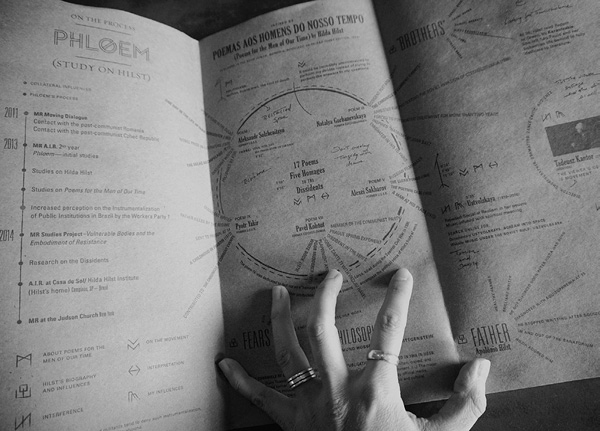
ON THE PROCESS—PHLOEM (STUDY ON HILST)
first performed on November 24, 2014
Movement Research at the Judson Church, New York, New York
performed once in 2014
CRISTIANE BOUGER
Johann Stollmeier / Bruna Michelin / Larissa Brandao
New York, USA / Curitiba, Brazil
149970362c149970362r149970362i149970362s149970362t149970362i149970362a149970362n149970362e149970362b149970362o149970362u149970362g149970362e149970362r149970362@149970362g149970362m149970362a149970362i149970362l149970362.149970362c149970362o149970362m
cristianebouger.com
ON THE PROCESS—PHLOEM (STUDY ON HILST)
CRISTIANE BOUGER
“On the Process—Phloem (Study on Hilst)” was the first installment of an expanded performance project influenced by the poetry and life of Brazilian writer Hilda Hilst (1930-2004). Inspired by Poems for the Men of Our Time (Poemas aos Homens do Nosso Tempo), I conceived this movement-based performance lecture as a way to consistently share the strategies, doubts and concerns around the construction of my work. Before the performance presentation, a diagram of the work process was distributed to each viewer.
When Hilst wrote Poems for the Men of Our Time in 1974, Brazil was under a military dictatorship, which, arguably, suppressed the insurgence of Communism in the country. It came to my attention that five poems in Hilst’s series were dedicated as homages to dissident writers of the communist regime in the former Soviet Union and Czechoslovakia: Aleksandr Solzhenitsyn (I), Natalya Gorbanevskaya (III), Alexei Sakharov (V), Pavel Kohout (VII), and Pyotr Yakir (IX). These five poems guided the creation of “Phloem.”
By intertwining and overlapping the performance lecture with the diagram and a video with the duration of the 16-minute performance, I crafted the core of my exposure on sharing process. The lecture focused on commentary about the performance score and content related to the work references; the diagram exposed the political persecution of each dissident, allowing the viewers to tap into their works, as well as to get a glimpse of “Phloem’s” structural aspects and further influences, which included the theater work of Tadeusz Kantor and the music of Russian composer Galina Ustvolskaya. It also pointed out aspects of Hilst’s biography and a timeline of the events that brought me to the creation of “Phloem.” The video, filmed in a single sequence frame, showed me in the role of the director who observes, and by this means, captured the movement of the viewer/critic as choreography. While my projected image on the background wall observed the performance, my uncertainties concerning the work were listened to as voice-over narration on the video. Close to the end of the performance, my feedback coming from the video interacted with my actual presence on the scene, exposing the multilayered roles implicit in my work (writer, director, video artist, and performer). The video cinematography was designed by Johann Stollmeier with editing by Bruna Michelin. I designed the diagram in collaboration with Larissa Brandao.